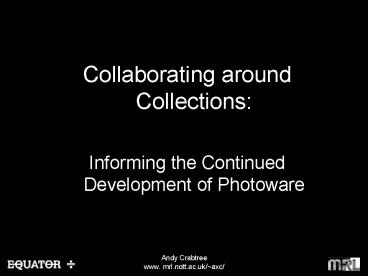Andy Crabtree PowerPoint PPT Presentation
1 / 20
Title: Andy Crabtree
1
- Collaborating around Collections
- Informing the Continued Development of Photoware
2
Collaborating around Collections
- Understanding collaboration around collections of
artefacts - Exploring ways in which collaboration around
collections of objects may be augmented and
enhanced by computer support - Section dedicated to the topic at CSCW 02
- Grinter et al. - museums and supporting visit
- Hindmarsh et al. - artworks and interaction with
assemblies of objects - Frohlich et al. - photographs and development of
photoware
3
Photoware
- This talk focuses on photoware
- i.e., on the development digital photography
- Look at some current examples and their
limitations with respect to collaboration - The salience of examining paper-based photograph
use for continued development - Reflect on the findings of ethnographic study
4
Photoware
- Why focus on photoware
- Developing new technologies for the home
- Ethnographic studies of technology use in homes
in the UK - Studies reported in design literature (e.g.,
HOIT, COOP, UbIComp, ECSCW, DIS, JCSCW) - In addition to communication media and PIM tools,
photographs a feature of our studies and relevant
to design
5
Photoware
- Current technologies and their limits
almost all research in how to support
experience sharing with digital data suffers from
the limitations of current display
technology. Shen et al. Sharing and
Building Digital Group Histories
6
Photoware
- Supporting experience sharing
While such interfaces permit sharing amongst a
group, it is not at all clear how they support
sharing amongst individual group members, however.
7
Photoware
- Supporting collaboration between individual group
members
Conversely, the small size of such devices limits
group interaction and highlights the need to make
photoware devices interoperable.
8
Photoware
- So whats the problem?
- Obviously all we need to do is combine devices
Perhaps the biggest gap in the photoware market
today is support for simple methods of remote
photo sharing. People are already successfully
exchanging digital photos with each other
asynchronously, but reverting to use of the
telephone in order to discuss them live with
remote partners. Hence there is an opportunity to
enhance current photo-sharing practices over the
telephone with what might be called
photo-conferencing tools. These might be
telephone, PC or TV centric, and should support
the kind of active audience participation that is
typical of co-present photo sharing. Frohlich
et al. Requirements for Photoware
9
Photoware
- So what are we going to do?
- Frohlich et al. not only look at the digital
but also how people interact with paper-based
photos - Explicate image-based communication practices
- By investigating photo talk
The study of naturalistic conversation within
Conversation Analysis has begun to identify
salient features of storytelling, but in the
absence of photographs and other image-based
materials.
10
Photoware
- Investigating photo talk
- Complementing ethnographies, interviews, and
self-reporting techniques - Interactionally embodied photo-talk
- Examining sequences of talk and practical action
in which photos are shared
11
Photoware
- Some precursors to interaction
12
Photoware
- Interactionally embodied photo talk the
phenomenal field
13
Photoware
- Some observations from the phenomenal field
- Sharing is an achieved feature of collaboration
- Features of achievement
- Production of accounts - photos as resources for
talk - Distribution and coordination from control
centre (group views, raising conversational
topics) - Movement of photos to and from outlying
positions (personal views, exploring topics away
from group) - Dynamics of sharing (divisions and
sub-divisions of group)
14
Photoware
- The phenomenal field
15
Photoware
- Some more observations from the phenomenal field
- Ad hoc assemblies and recipient design of photo
talk - Establishing and maintaining mutual sense of
account in conversation the importance of
gesture - e.g., pointing at an area of a photograph is
accompanied by tapping on the area to establish
the precise sense of a question. - or moving the pointing finger from area to area
to draw connections between images - and moving the finger over a photograph in a
circular motion to indicate that some
commonality between or grouping of the
constituent parts of an image. - Gestures make grammatical distinctions and
provide a moment-by-moment orientation to
assemblages, giving talk its situated meaning
16
Photoware
- So what of these mundane events?
- Some implications for design
- Local practices of use, distribution and
coordination provide a resource for thinking
about supporting the achievement of remote
sharing or sharing at a distance
17
Photoware
- Local practices of sharing
- Storage and retrieval ecological habitats and
access control - Physicality of photos an ecology of practices
that allow for distribution and coordination - Digital alternatives and the potential of
disconnection between ecologies of praxis that
give photos their meaning on occasions of their
collaborative use - Key concern to move beyond storage and
manipulation (networking and tangible techniques)
to also consider developing support for the
production of accounts
18
Photoware
- Supporting the production of accounts
- Developing distributed means of multiparticipant
telecollaboration - Including, telepointing and telepainting
software to support gestural practices - And underlying data spaces to permit
- Ad hoc assemblies at a distance
- Distribution from control centres to outlying
devices - And between outlying devices
- Coordination protocols for management of
distribution (in and out)
19
Photoware
- Related issues
- Duplication and support for ownership, transfer,
and control - Privacy and security gatekeeping
- Awareness mechanisms to support tracking
20
(No Transcript)

